International Marketing Management Report: Alibaba Case Study
VerifiedAdded on 2023/01/11
|12
|2363
|66
Report
AI Summary
This report provides a comprehensive analysis of Alibaba's international marketing strategies, focusing on its adaptation to the global business environment. The study begins with an introduction to the concept of international marketing and highlights the adjustments required to attract target markets. It examines Alibaba's global environment using PESTEL analysis, exploring political, economic, social, technological, environmental, and legal factors influencing its operations. The report delves into international marketing strategies, discussing product selection, pricing, place, and promotion. It then examines Alibaba's market entry approaches, including turnkey operations and licensing strategies. The core of the report is a detailed analysis of Alibaba's marketing mix, illustrating how the company has adapted its strategies in response to the global environment, particularly its shift from B2C to B2B in the United States. The report concludes by summarizing the influence of the global business environment on Alibaba's international marketing strategy and its strategic management of market entry, emphasizing the importance of tailoring strategies to specific markets.
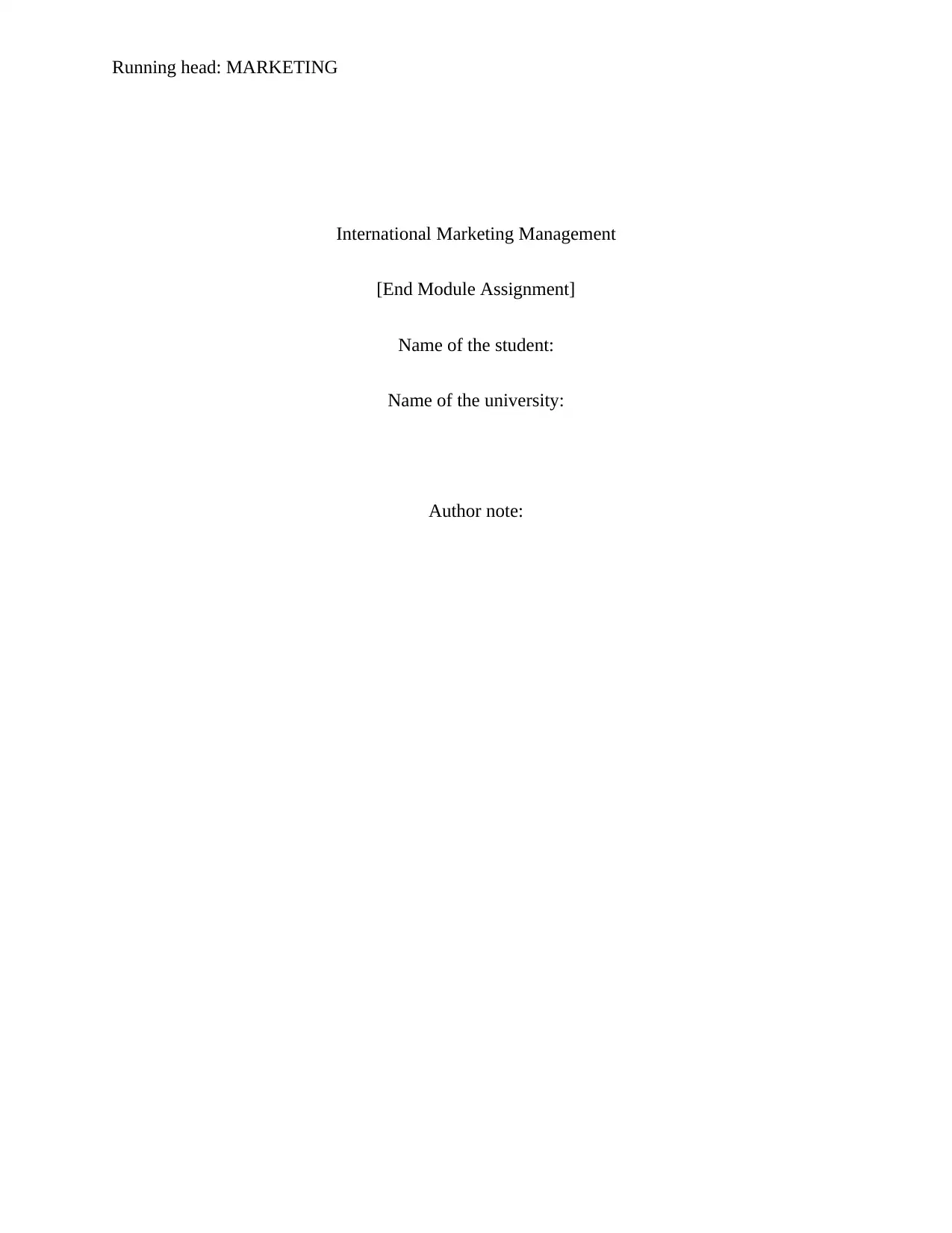
Running head: MARKETING
International Marketing Management
[End Module Assignment]
Name of the student:
Name of the university:
Author note:
International Marketing Management
[End Module Assignment]
Name of the student:
Name of the university:
Author note:
Paraphrase This Document
Need a fresh take? Get an instant paraphrase of this document with our AI Paraphraser
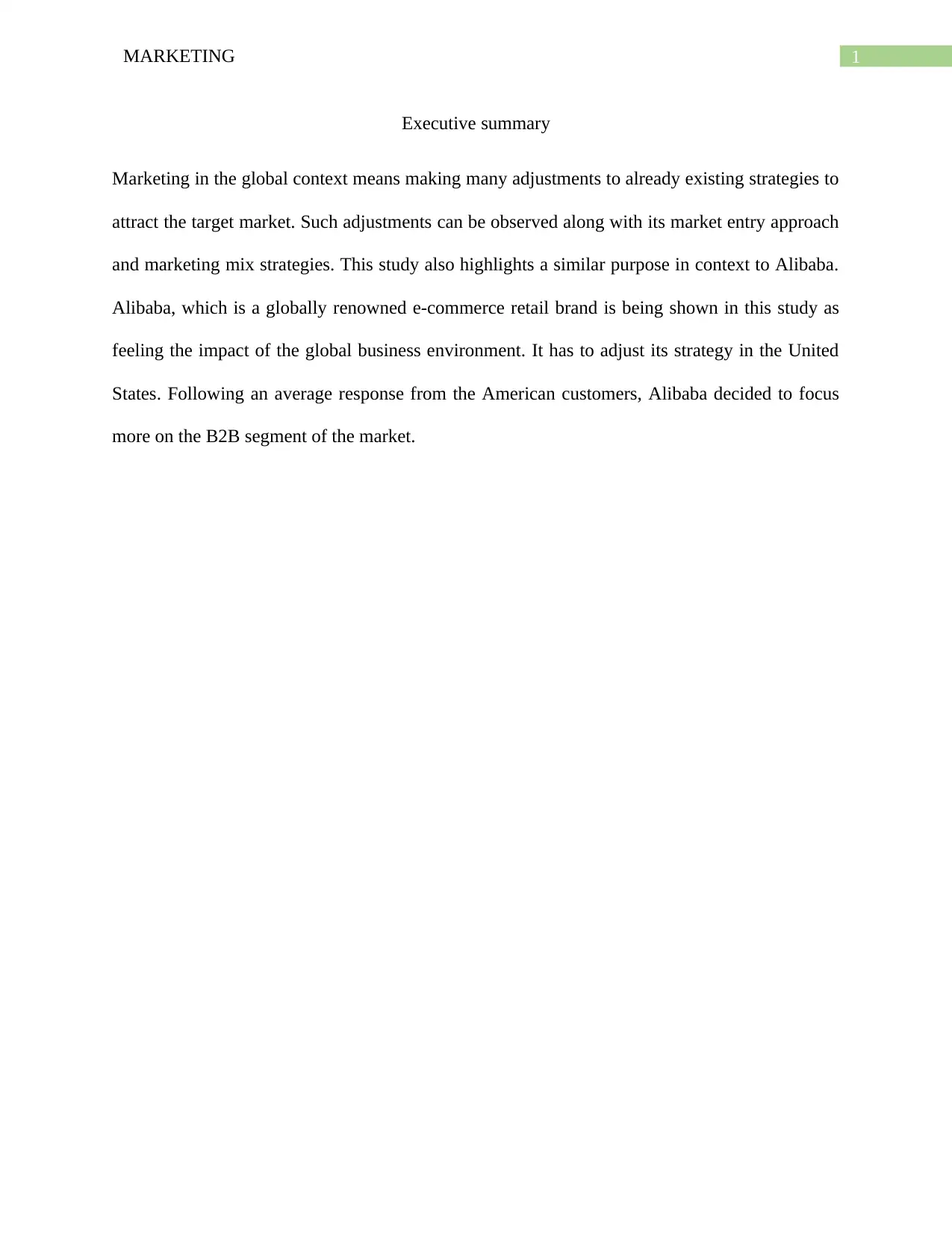
1MARKETING
Executive summary
Marketing in the global context means making many adjustments to already existing strategies to
attract the target market. Such adjustments can be observed along with its market entry approach
and marketing mix strategies. This study also highlights a similar purpose in context to Alibaba.
Alibaba, which is a globally renowned e-commerce retail brand is being shown in this study as
feeling the impact of the global business environment. It has to adjust its strategy in the United
States. Following an average response from the American customers, Alibaba decided to focus
more on the B2B segment of the market.
Executive summary
Marketing in the global context means making many adjustments to already existing strategies to
attract the target market. Such adjustments can be observed along with its market entry approach
and marketing mix strategies. This study also highlights a similar purpose in context to Alibaba.
Alibaba, which is a globally renowned e-commerce retail brand is being shown in this study as
feeling the impact of the global business environment. It has to adjust its strategy in the United
States. Following an average response from the American customers, Alibaba decided to focus
more on the B2B segment of the market.
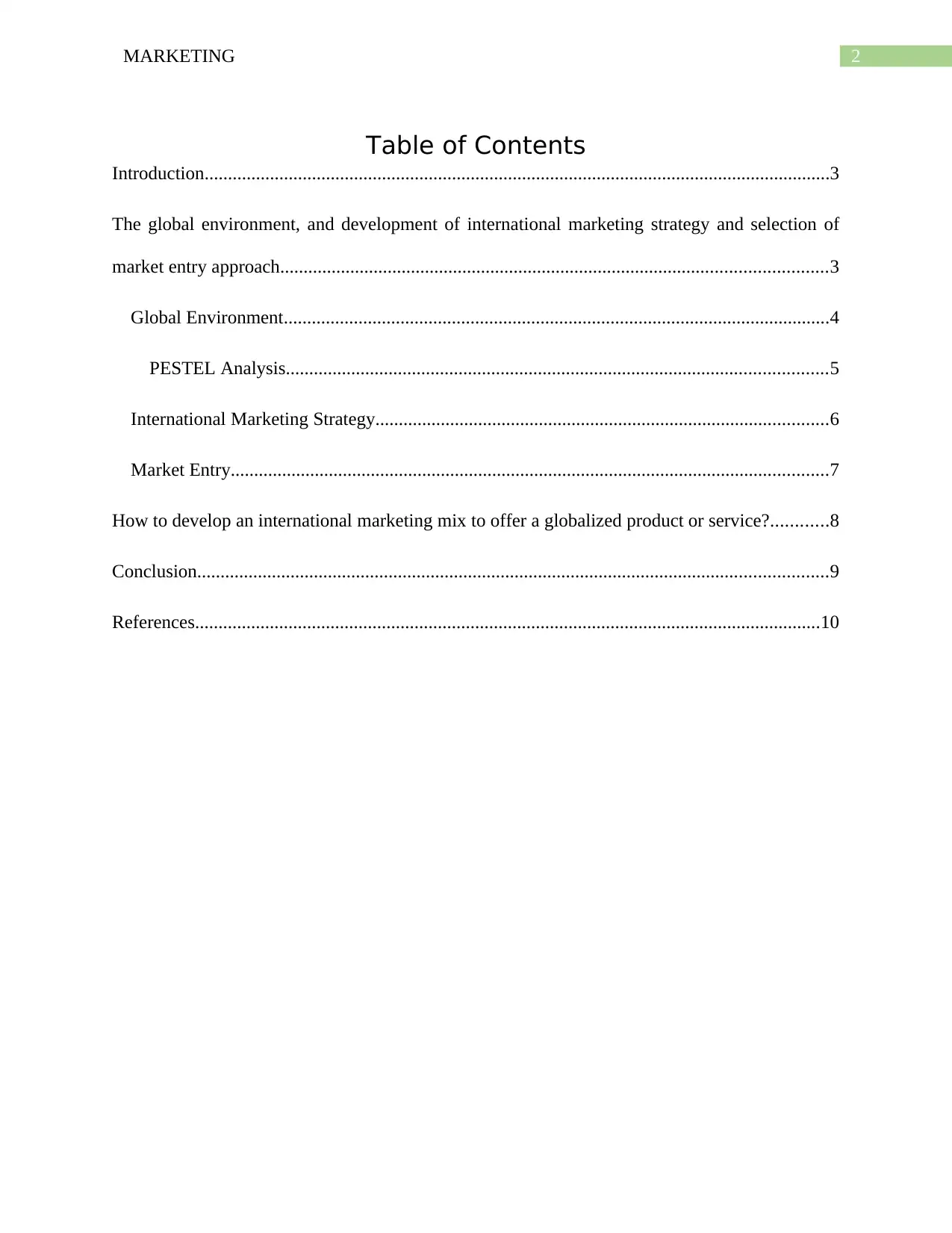
2MARKETING
Table of Contents
Introduction......................................................................................................................................3
The global environment, and development of international marketing strategy and selection of
market entry approach.....................................................................................................................3
Global Environment.....................................................................................................................4
PESTEL Analysis....................................................................................................................5
International Marketing Strategy.................................................................................................6
Market Entry................................................................................................................................7
How to develop an international marketing mix to offer a globalized product or service?............8
Conclusion.......................................................................................................................................9
References......................................................................................................................................10
Table of Contents
Introduction......................................................................................................................................3
The global environment, and development of international marketing strategy and selection of
market entry approach.....................................................................................................................3
Global Environment.....................................................................................................................4
PESTEL Analysis....................................................................................................................5
International Marketing Strategy.................................................................................................6
Market Entry................................................................................................................................7
How to develop an international marketing mix to offer a globalized product or service?............8
Conclusion.......................................................................................................................................9
References......................................................................................................................................10
⊘ This is a preview!⊘
Do you want full access?
Subscribe today to unlock all pages.

Trusted by 1+ million students worldwide
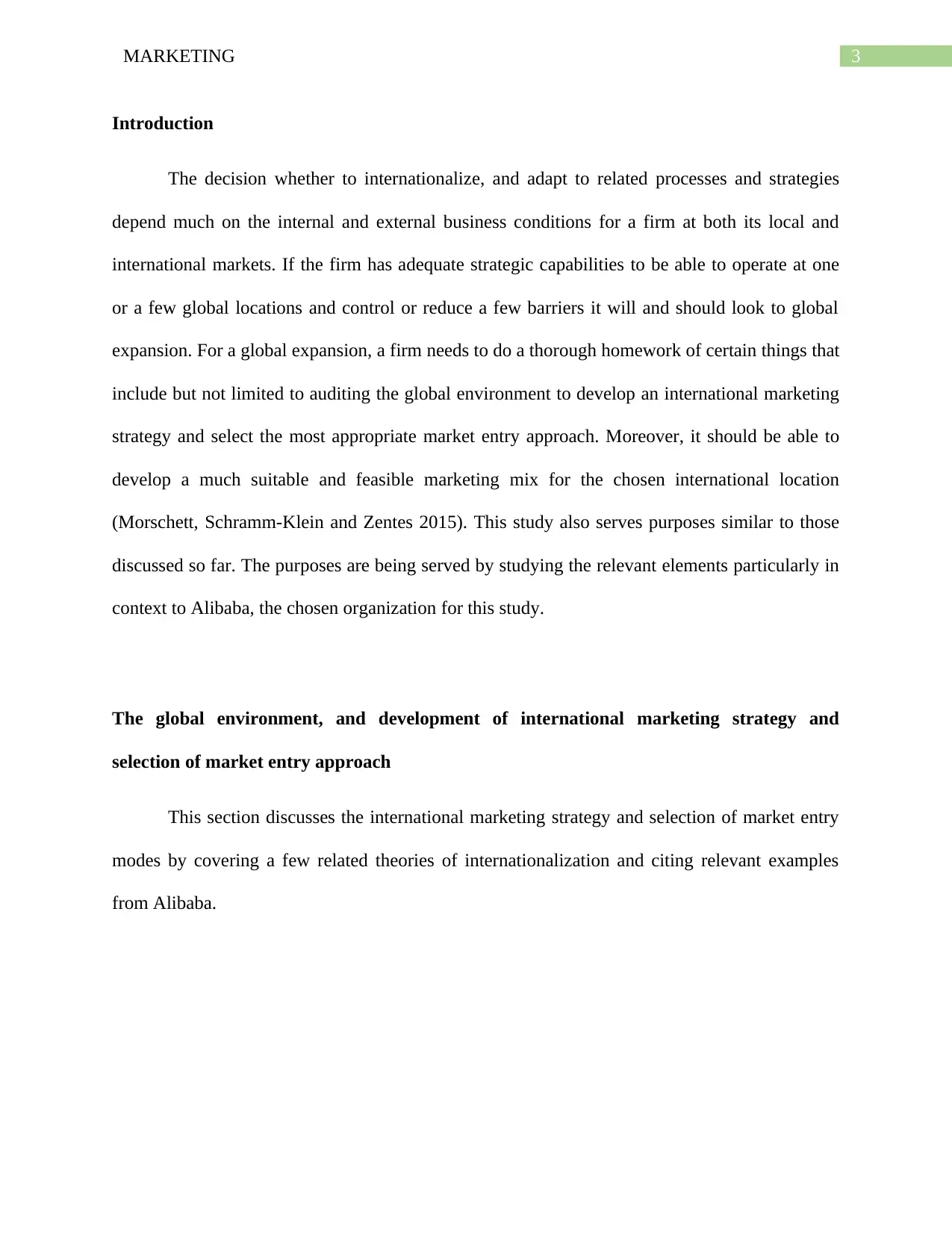
3MARKETING
Introduction
The decision whether to internationalize, and adapt to related processes and strategies
depend much on the internal and external business conditions for a firm at both its local and
international markets. If the firm has adequate strategic capabilities to be able to operate at one
or a few global locations and control or reduce a few barriers it will and should look to global
expansion. For a global expansion, a firm needs to do a thorough homework of certain things that
include but not limited to auditing the global environment to develop an international marketing
strategy and select the most appropriate market entry approach. Moreover, it should be able to
develop a much suitable and feasible marketing mix for the chosen international location
(Morschett, Schramm-Klein and Zentes 2015). This study also serves purposes similar to those
discussed so far. The purposes are being served by studying the relevant elements particularly in
context to Alibaba, the chosen organization for this study.
The global environment, and development of international marketing strategy and
selection of market entry approach
This section discusses the international marketing strategy and selection of market entry
modes by covering a few related theories of internationalization and citing relevant examples
from Alibaba.
Introduction
The decision whether to internationalize, and adapt to related processes and strategies
depend much on the internal and external business conditions for a firm at both its local and
international markets. If the firm has adequate strategic capabilities to be able to operate at one
or a few global locations and control or reduce a few barriers it will and should look to global
expansion. For a global expansion, a firm needs to do a thorough homework of certain things that
include but not limited to auditing the global environment to develop an international marketing
strategy and select the most appropriate market entry approach. Moreover, it should be able to
develop a much suitable and feasible marketing mix for the chosen international location
(Morschett, Schramm-Klein and Zentes 2015). This study also serves purposes similar to those
discussed so far. The purposes are being served by studying the relevant elements particularly in
context to Alibaba, the chosen organization for this study.
The global environment, and development of international marketing strategy and
selection of market entry approach
This section discusses the international marketing strategy and selection of market entry
modes by covering a few related theories of internationalization and citing relevant examples
from Alibaba.
Paraphrase This Document
Need a fresh take? Get an instant paraphrase of this document with our AI Paraphraser
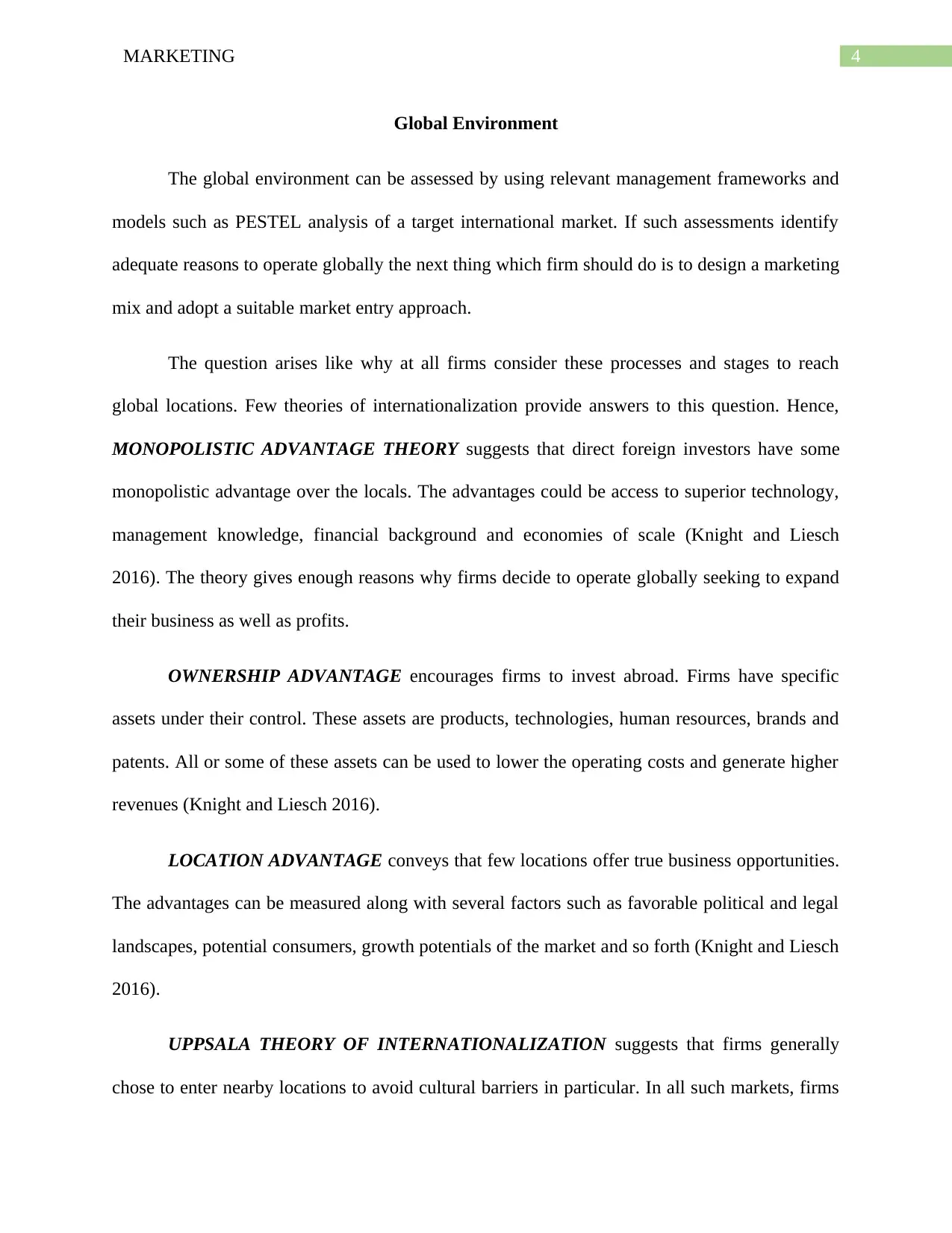
4MARKETING
Global Environment
The global environment can be assessed by using relevant management frameworks and
models such as PESTEL analysis of a target international market. If such assessments identify
adequate reasons to operate globally the next thing which firm should do is to design a marketing
mix and adopt a suitable market entry approach.
The question arises like why at all firms consider these processes and stages to reach
global locations. Few theories of internationalization provide answers to this question. Hence,
MONOPOLISTIC ADVANTAGE THEORY suggests that direct foreign investors have some
monopolistic advantage over the locals. The advantages could be access to superior technology,
management knowledge, financial background and economies of scale (Knight and Liesch
2016). The theory gives enough reasons why firms decide to operate globally seeking to expand
their business as well as profits.
OWNERSHIP ADVANTAGE encourages firms to invest abroad. Firms have specific
assets under their control. These assets are products, technologies, human resources, brands and
patents. All or some of these assets can be used to lower the operating costs and generate higher
revenues (Knight and Liesch 2016).
LOCATION ADVANTAGE conveys that few locations offer true business opportunities.
The advantages can be measured along with several factors such as favorable political and legal
landscapes, potential consumers, growth potentials of the market and so forth (Knight and Liesch
2016).
UPPSALA THEORY OF INTERNATIONALIZATION suggests that firms generally
chose to enter nearby locations to avoid cultural barriers in particular. In all such markets, firms
Global Environment
The global environment can be assessed by using relevant management frameworks and
models such as PESTEL analysis of a target international market. If such assessments identify
adequate reasons to operate globally the next thing which firm should do is to design a marketing
mix and adopt a suitable market entry approach.
The question arises like why at all firms consider these processes and stages to reach
global locations. Few theories of internationalization provide answers to this question. Hence,
MONOPOLISTIC ADVANTAGE THEORY suggests that direct foreign investors have some
monopolistic advantage over the locals. The advantages could be access to superior technology,
management knowledge, financial background and economies of scale (Knight and Liesch
2016). The theory gives enough reasons why firms decide to operate globally seeking to expand
their business as well as profits.
OWNERSHIP ADVANTAGE encourages firms to invest abroad. Firms have specific
assets under their control. These assets are products, technologies, human resources, brands and
patents. All or some of these assets can be used to lower the operating costs and generate higher
revenues (Knight and Liesch 2016).
LOCATION ADVANTAGE conveys that few locations offer true business opportunities.
The advantages can be measured along with several factors such as favorable political and legal
landscapes, potential consumers, growth potentials of the market and so forth (Knight and Liesch
2016).
UPPSALA THEORY OF INTERNATIONALIZATION suggests that firms generally
chose to enter nearby locations to avoid cultural barriers in particular. In all such markets, firms
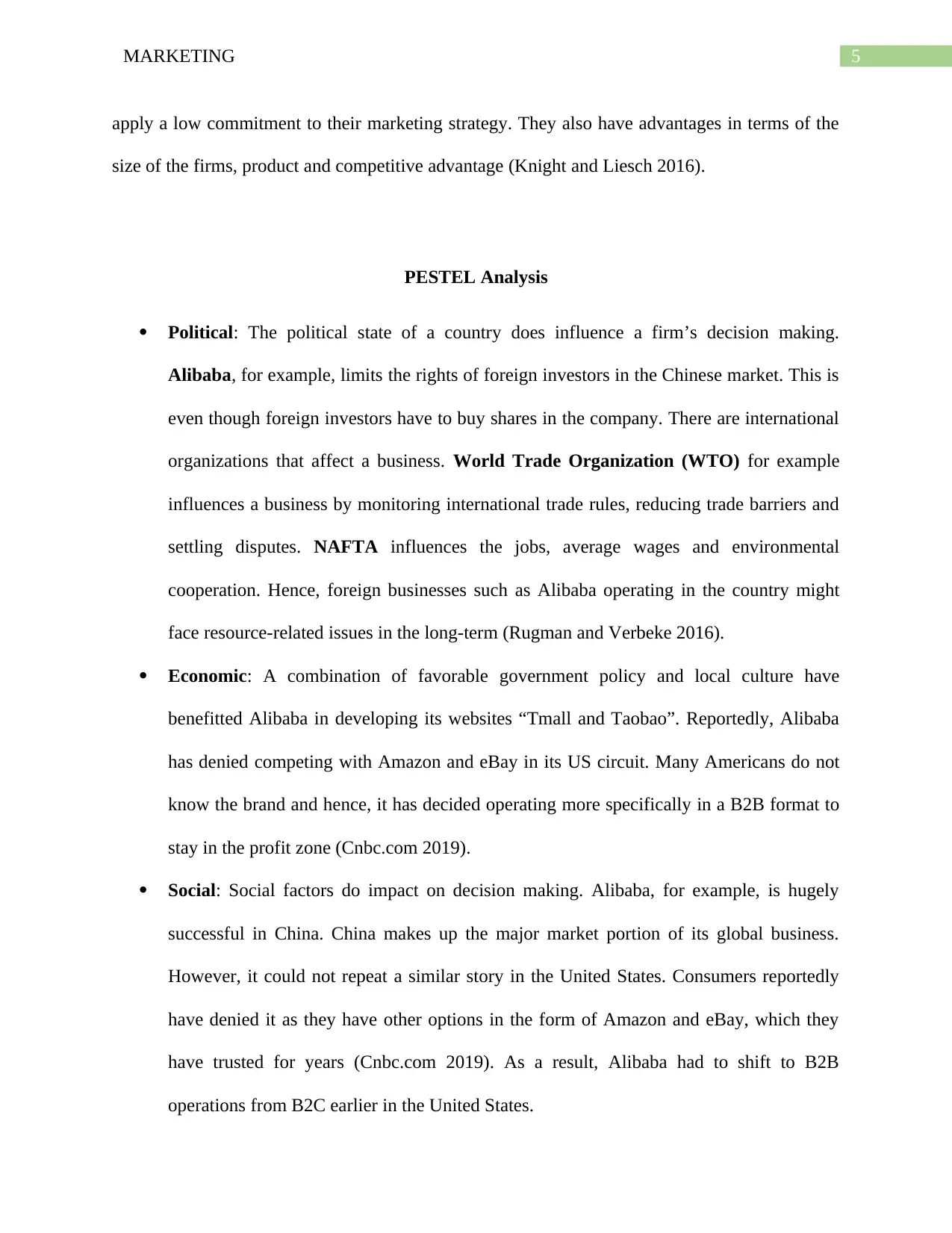
5MARKETING
apply a low commitment to their marketing strategy. They also have advantages in terms of the
size of the firms, product and competitive advantage (Knight and Liesch 2016).
PESTEL Analysis
Political: The political state of a country does influence a firm’s decision making.
Alibaba, for example, limits the rights of foreign investors in the Chinese market. This is
even though foreign investors have to buy shares in the company. There are international
organizations that affect a business. World Trade Organization (WTO) for example
influences a business by monitoring international trade rules, reducing trade barriers and
settling disputes. NAFTA influences the jobs, average wages and environmental
cooperation. Hence, foreign businesses such as Alibaba operating in the country might
face resource-related issues in the long-term (Rugman and Verbeke 2016).
Economic: A combination of favorable government policy and local culture have
benefitted Alibaba in developing its websites “Tmall and Taobao”. Reportedly, Alibaba
has denied competing with Amazon and eBay in its US circuit. Many Americans do not
know the brand and hence, it has decided operating more specifically in a B2B format to
stay in the profit zone (Cnbc.com 2019).
Social: Social factors do impact on decision making. Alibaba, for example, is hugely
successful in China. China makes up the major market portion of its global business.
However, it could not repeat a similar story in the United States. Consumers reportedly
have denied it as they have other options in the form of Amazon and eBay, which they
have trusted for years (Cnbc.com 2019). As a result, Alibaba had to shift to B2B
operations from B2C earlier in the United States.
apply a low commitment to their marketing strategy. They also have advantages in terms of the
size of the firms, product and competitive advantage (Knight and Liesch 2016).
PESTEL Analysis
Political: The political state of a country does influence a firm’s decision making.
Alibaba, for example, limits the rights of foreign investors in the Chinese market. This is
even though foreign investors have to buy shares in the company. There are international
organizations that affect a business. World Trade Organization (WTO) for example
influences a business by monitoring international trade rules, reducing trade barriers and
settling disputes. NAFTA influences the jobs, average wages and environmental
cooperation. Hence, foreign businesses such as Alibaba operating in the country might
face resource-related issues in the long-term (Rugman and Verbeke 2016).
Economic: A combination of favorable government policy and local culture have
benefitted Alibaba in developing its websites “Tmall and Taobao”. Reportedly, Alibaba
has denied competing with Amazon and eBay in its US circuit. Many Americans do not
know the brand and hence, it has decided operating more specifically in a B2B format to
stay in the profit zone (Cnbc.com 2019).
Social: Social factors do impact on decision making. Alibaba, for example, is hugely
successful in China. China makes up the major market portion of its global business.
However, it could not repeat a similar story in the United States. Consumers reportedly
have denied it as they have other options in the form of Amazon and eBay, which they
have trusted for years (Cnbc.com 2019). As a result, Alibaba had to shift to B2B
operations from B2C earlier in the United States.
⊘ This is a preview!⊘
Do you want full access?
Subscribe today to unlock all pages.

Trusted by 1+ million students worldwide
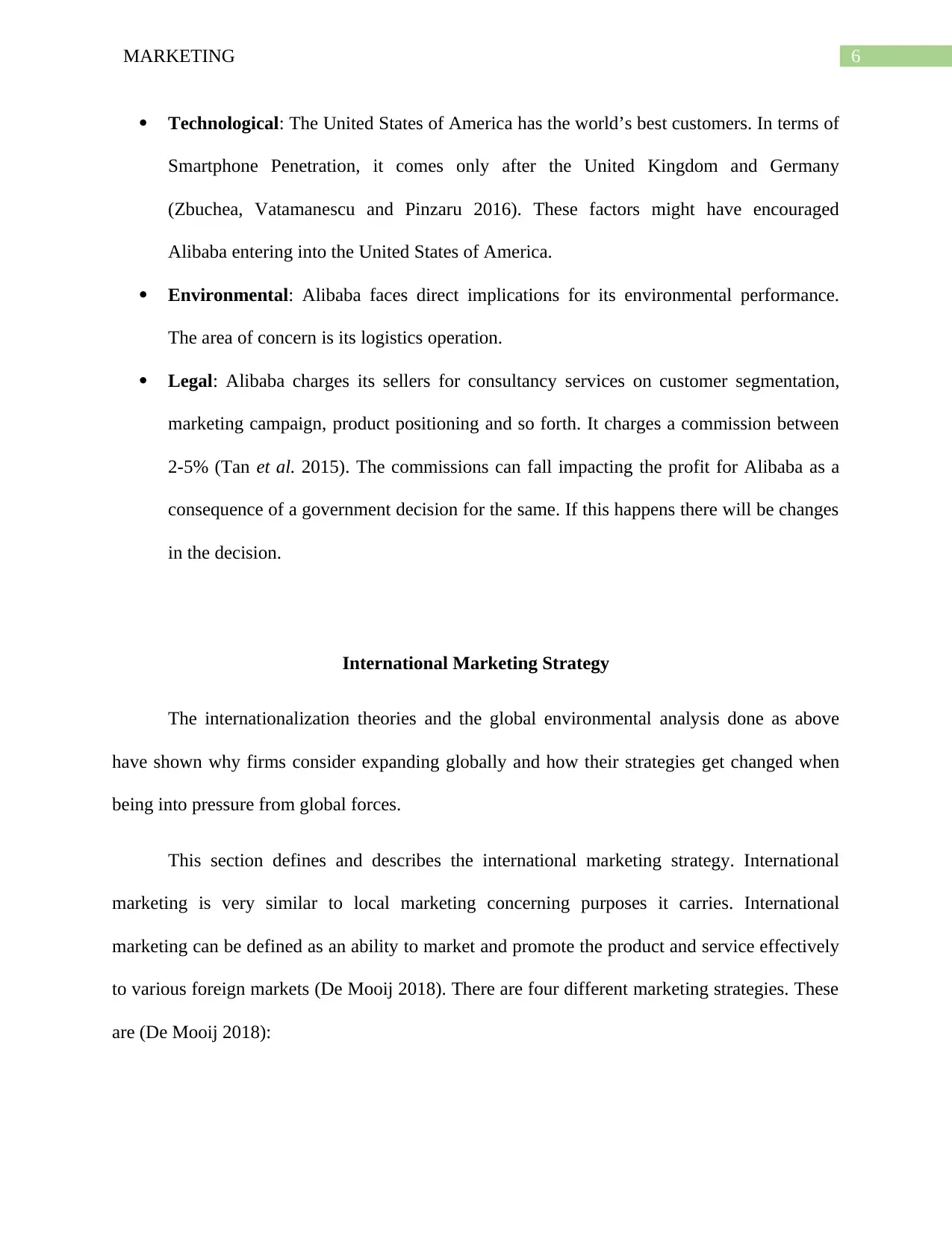
6MARKETING
Technological: The United States of America has the world’s best customers. In terms of
Smartphone Penetration, it comes only after the United Kingdom and Germany
(Zbuchea, Vatamanescu and Pinzaru 2016). These factors might have encouraged
Alibaba entering into the United States of America.
Environmental: Alibaba faces direct implications for its environmental performance.
The area of concern is its logistics operation.
Legal: Alibaba charges its sellers for consultancy services on customer segmentation,
marketing campaign, product positioning and so forth. It charges a commission between
2-5% (Tan et al. 2015). The commissions can fall impacting the profit for Alibaba as a
consequence of a government decision for the same. If this happens there will be changes
in the decision.
International Marketing Strategy
The internationalization theories and the global environmental analysis done as above
have shown why firms consider expanding globally and how their strategies get changed when
being into pressure from global forces.
This section defines and describes the international marketing strategy. International
marketing is very similar to local marketing concerning purposes it carries. International
marketing can be defined as an ability to market and promote the product and service effectively
to various foreign markets (De Mooij 2018). There are four different marketing strategies. These
are (De Mooij 2018):
Technological: The United States of America has the world’s best customers. In terms of
Smartphone Penetration, it comes only after the United Kingdom and Germany
(Zbuchea, Vatamanescu and Pinzaru 2016). These factors might have encouraged
Alibaba entering into the United States of America.
Environmental: Alibaba faces direct implications for its environmental performance.
The area of concern is its logistics operation.
Legal: Alibaba charges its sellers for consultancy services on customer segmentation,
marketing campaign, product positioning and so forth. It charges a commission between
2-5% (Tan et al. 2015). The commissions can fall impacting the profit for Alibaba as a
consequence of a government decision for the same. If this happens there will be changes
in the decision.
International Marketing Strategy
The internationalization theories and the global environmental analysis done as above
have shown why firms consider expanding globally and how their strategies get changed when
being into pressure from global forces.
This section defines and describes the international marketing strategy. International
marketing is very similar to local marketing concerning purposes it carries. International
marketing can be defined as an ability to market and promote the product and service effectively
to various foreign markets (De Mooij 2018). There are four different marketing strategies. These
are (De Mooij 2018):
Paraphrase This Document
Need a fresh take? Get an instant paraphrase of this document with our AI Paraphraser
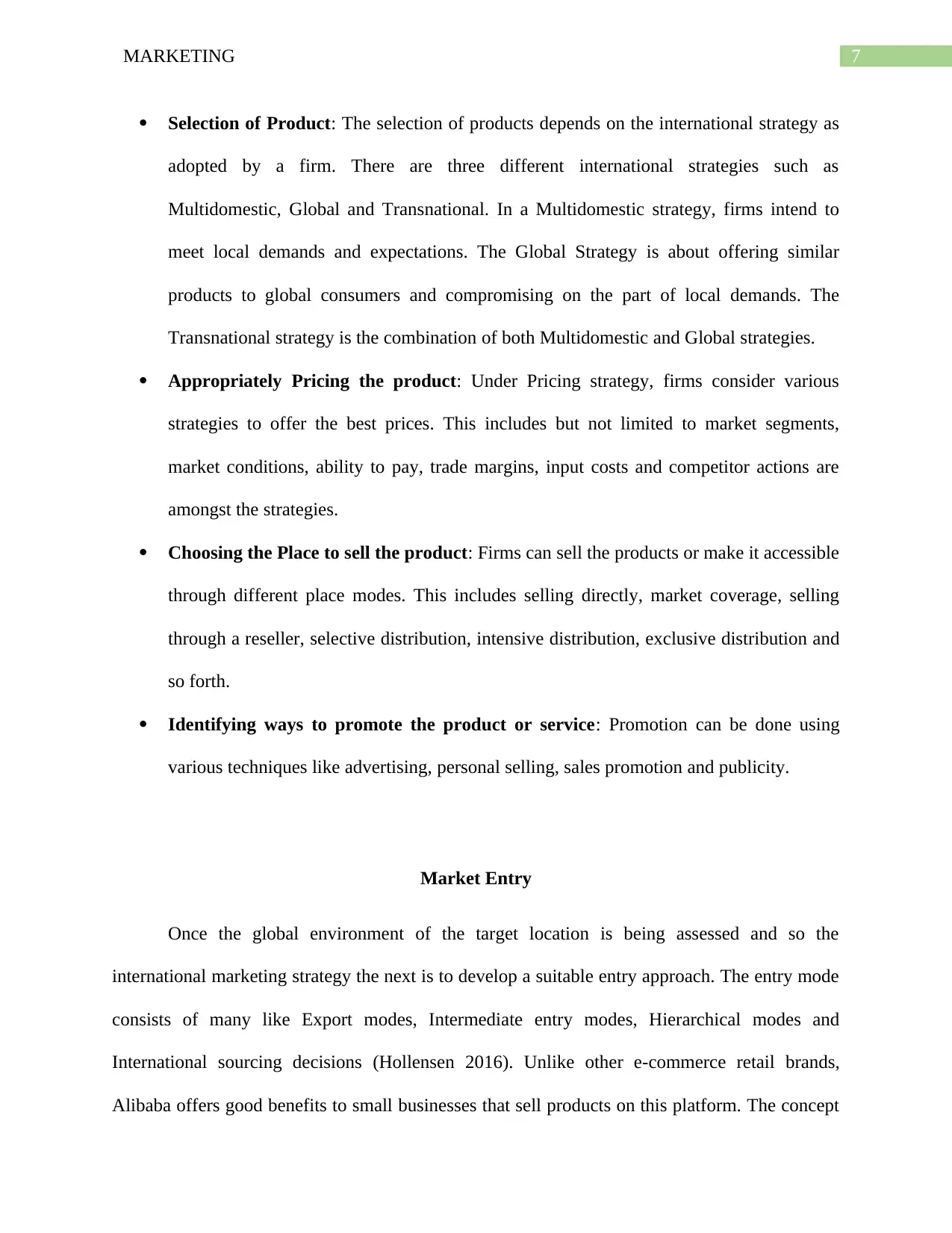
7MARKETING
Selection of Product: The selection of products depends on the international strategy as
adopted by a firm. There are three different international strategies such as
Multidomestic, Global and Transnational. In a Multidomestic strategy, firms intend to
meet local demands and expectations. The Global Strategy is about offering similar
products to global consumers and compromising on the part of local demands. The
Transnational strategy is the combination of both Multidomestic and Global strategies.
Appropriately Pricing the product: Under Pricing strategy, firms consider various
strategies to offer the best prices. This includes but not limited to market segments,
market conditions, ability to pay, trade margins, input costs and competitor actions are
amongst the strategies.
Choosing the Place to sell the product: Firms can sell the products or make it accessible
through different place modes. This includes selling directly, market coverage, selling
through a reseller, selective distribution, intensive distribution, exclusive distribution and
so forth.
Identifying ways to promote the product or service: Promotion can be done using
various techniques like advertising, personal selling, sales promotion and publicity.
Market Entry
Once the global environment of the target location is being assessed and so the
international marketing strategy the next is to develop a suitable entry approach. The entry mode
consists of many like Export modes, Intermediate entry modes, Hierarchical modes and
International sourcing decisions (Hollensen 2016). Unlike other e-commerce retail brands,
Alibaba offers good benefits to small businesses that sell products on this platform. The concept
Selection of Product: The selection of products depends on the international strategy as
adopted by a firm. There are three different international strategies such as
Multidomestic, Global and Transnational. In a Multidomestic strategy, firms intend to
meet local demands and expectations. The Global Strategy is about offering similar
products to global consumers and compromising on the part of local demands. The
Transnational strategy is the combination of both Multidomestic and Global strategies.
Appropriately Pricing the product: Under Pricing strategy, firms consider various
strategies to offer the best prices. This includes but not limited to market segments,
market conditions, ability to pay, trade margins, input costs and competitor actions are
amongst the strategies.
Choosing the Place to sell the product: Firms can sell the products or make it accessible
through different place modes. This includes selling directly, market coverage, selling
through a reseller, selective distribution, intensive distribution, exclusive distribution and
so forth.
Identifying ways to promote the product or service: Promotion can be done using
various techniques like advertising, personal selling, sales promotion and publicity.
Market Entry
Once the global environment of the target location is being assessed and so the
international marketing strategy the next is to develop a suitable entry approach. The entry mode
consists of many like Export modes, Intermediate entry modes, Hierarchical modes and
International sourcing decisions (Hollensen 2016). Unlike other e-commerce retail brands,
Alibaba offers good benefits to small businesses that sell products on this platform. The concept
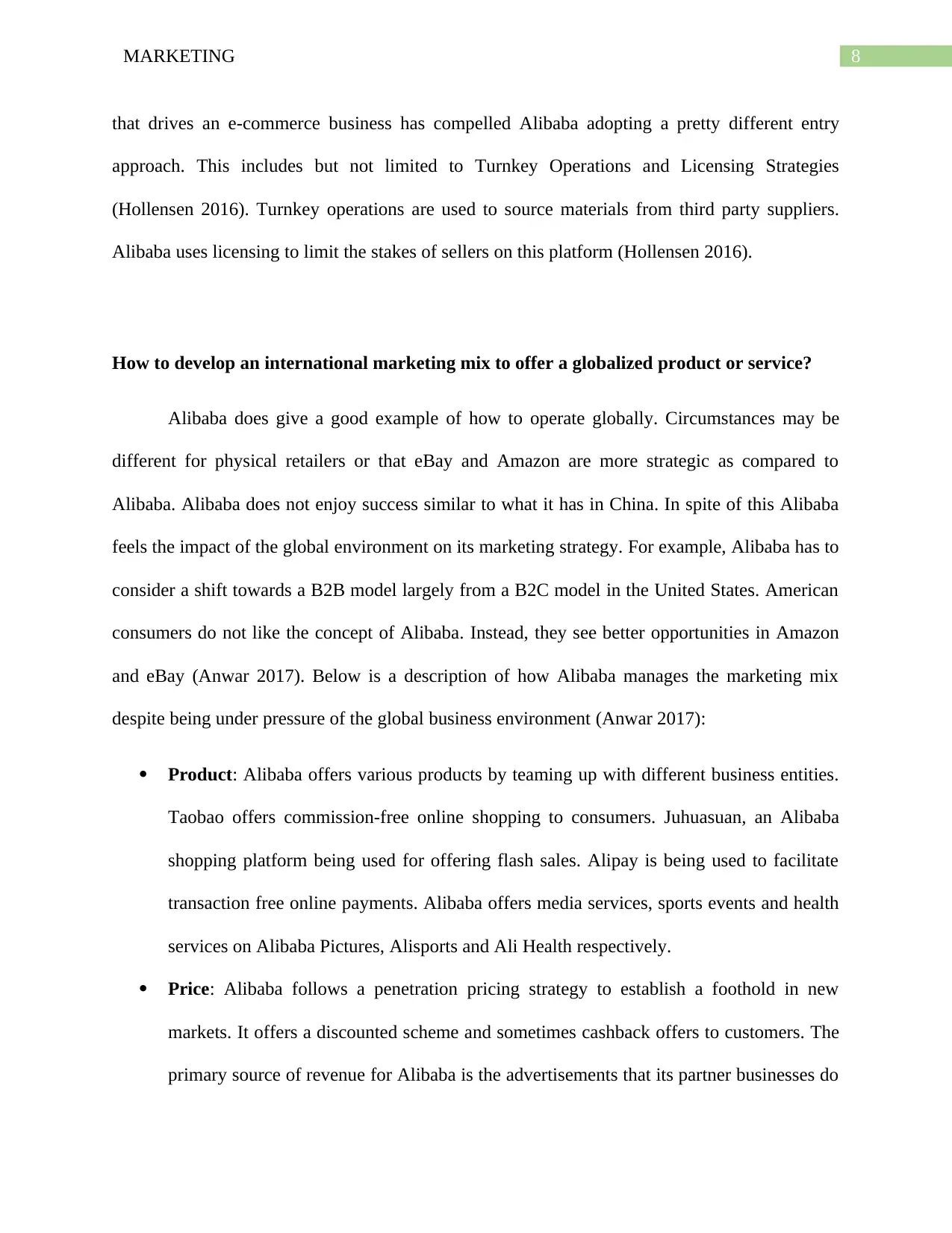
8MARKETING
that drives an e-commerce business has compelled Alibaba adopting a pretty different entry
approach. This includes but not limited to Turnkey Operations and Licensing Strategies
(Hollensen 2016). Turnkey operations are used to source materials from third party suppliers.
Alibaba uses licensing to limit the stakes of sellers on this platform (Hollensen 2016).
How to develop an international marketing mix to offer a globalized product or service?
Alibaba does give a good example of how to operate globally. Circumstances may be
different for physical retailers or that eBay and Amazon are more strategic as compared to
Alibaba. Alibaba does not enjoy success similar to what it has in China. In spite of this Alibaba
feels the impact of the global environment on its marketing strategy. For example, Alibaba has to
consider a shift towards a B2B model largely from a B2C model in the United States. American
consumers do not like the concept of Alibaba. Instead, they see better opportunities in Amazon
and eBay (Anwar 2017). Below is a description of how Alibaba manages the marketing mix
despite being under pressure of the global business environment (Anwar 2017):
Product: Alibaba offers various products by teaming up with different business entities.
Taobao offers commission-free online shopping to consumers. Juhuasuan, an Alibaba
shopping platform being used for offering flash sales. Alipay is being used to facilitate
transaction free online payments. Alibaba offers media services, sports events and health
services on Alibaba Pictures, Alisports and Ali Health respectively.
Price: Alibaba follows a penetration pricing strategy to establish a foothold in new
markets. It offers a discounted scheme and sometimes cashback offers to customers. The
primary source of revenue for Alibaba is the advertisements that its partner businesses do
that drives an e-commerce business has compelled Alibaba adopting a pretty different entry
approach. This includes but not limited to Turnkey Operations and Licensing Strategies
(Hollensen 2016). Turnkey operations are used to source materials from third party suppliers.
Alibaba uses licensing to limit the stakes of sellers on this platform (Hollensen 2016).
How to develop an international marketing mix to offer a globalized product or service?
Alibaba does give a good example of how to operate globally. Circumstances may be
different for physical retailers or that eBay and Amazon are more strategic as compared to
Alibaba. Alibaba does not enjoy success similar to what it has in China. In spite of this Alibaba
feels the impact of the global environment on its marketing strategy. For example, Alibaba has to
consider a shift towards a B2B model largely from a B2C model in the United States. American
consumers do not like the concept of Alibaba. Instead, they see better opportunities in Amazon
and eBay (Anwar 2017). Below is a description of how Alibaba manages the marketing mix
despite being under pressure of the global business environment (Anwar 2017):
Product: Alibaba offers various products by teaming up with different business entities.
Taobao offers commission-free online shopping to consumers. Juhuasuan, an Alibaba
shopping platform being used for offering flash sales. Alipay is being used to facilitate
transaction free online payments. Alibaba offers media services, sports events and health
services on Alibaba Pictures, Alisports and Ali Health respectively.
Price: Alibaba follows a penetration pricing strategy to establish a foothold in new
markets. It offers a discounted scheme and sometimes cashback offers to customers. The
primary source of revenue for Alibaba is the advertisements that its partner businesses do
⊘ This is a preview!⊘
Do you want full access?
Subscribe today to unlock all pages.

Trusted by 1+ million students worldwide
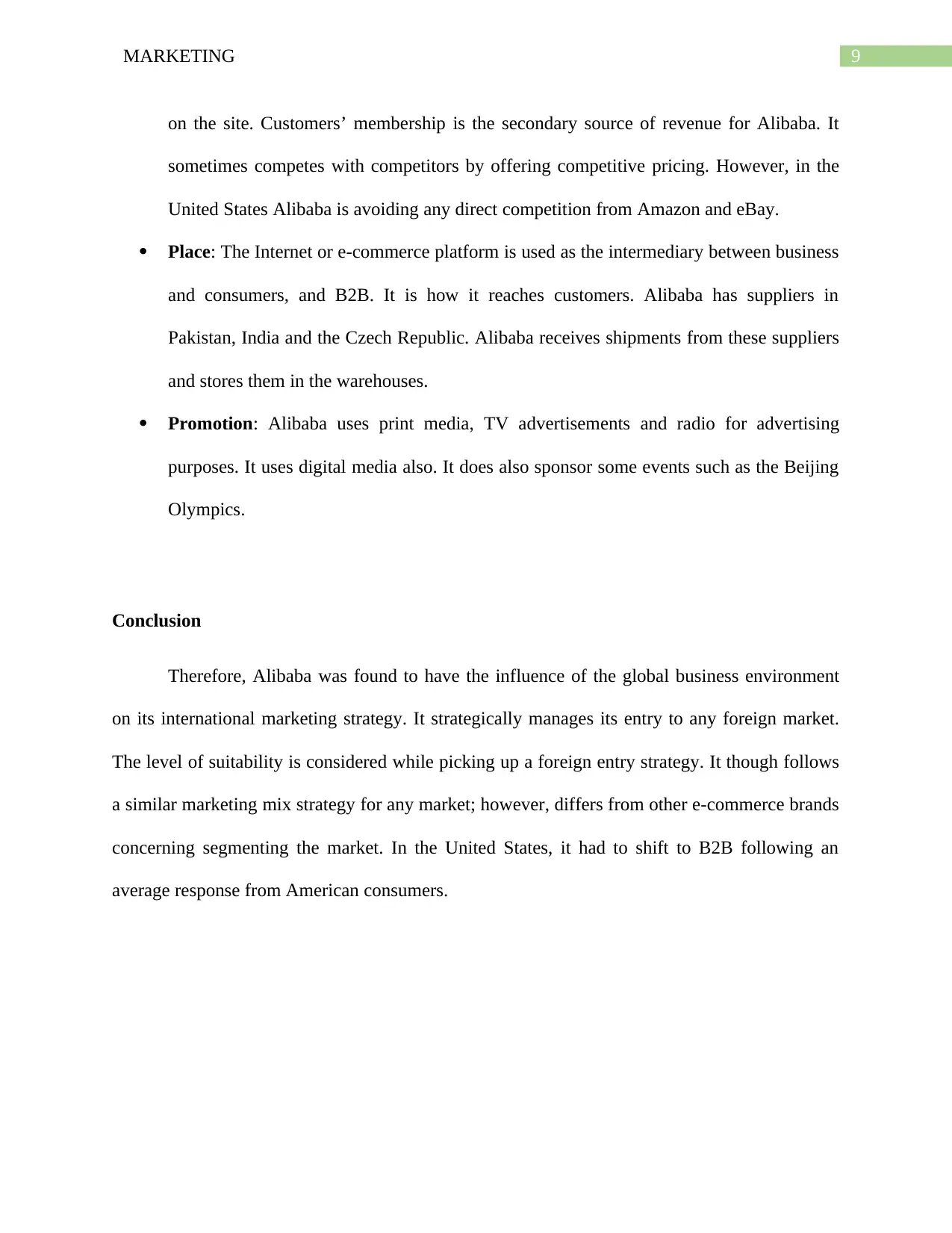
9MARKETING
on the site. Customers’ membership is the secondary source of revenue for Alibaba. It
sometimes competes with competitors by offering competitive pricing. However, in the
United States Alibaba is avoiding any direct competition from Amazon and eBay.
Place: The Internet or e-commerce platform is used as the intermediary between business
and consumers, and B2B. It is how it reaches customers. Alibaba has suppliers in
Pakistan, India and the Czech Republic. Alibaba receives shipments from these suppliers
and stores them in the warehouses.
Promotion: Alibaba uses print media, TV advertisements and radio for advertising
purposes. It uses digital media also. It does also sponsor some events such as the Beijing
Olympics.
Conclusion
Therefore, Alibaba was found to have the influence of the global business environment
on its international marketing strategy. It strategically manages its entry to any foreign market.
The level of suitability is considered while picking up a foreign entry strategy. It though follows
a similar marketing mix strategy for any market; however, differs from other e-commerce brands
concerning segmenting the market. In the United States, it had to shift to B2B following an
average response from American consumers.
on the site. Customers’ membership is the secondary source of revenue for Alibaba. It
sometimes competes with competitors by offering competitive pricing. However, in the
United States Alibaba is avoiding any direct competition from Amazon and eBay.
Place: The Internet or e-commerce platform is used as the intermediary between business
and consumers, and B2B. It is how it reaches customers. Alibaba has suppliers in
Pakistan, India and the Czech Republic. Alibaba receives shipments from these suppliers
and stores them in the warehouses.
Promotion: Alibaba uses print media, TV advertisements and radio for advertising
purposes. It uses digital media also. It does also sponsor some events such as the Beijing
Olympics.
Conclusion
Therefore, Alibaba was found to have the influence of the global business environment
on its international marketing strategy. It strategically manages its entry to any foreign market.
The level of suitability is considered while picking up a foreign entry strategy. It though follows
a similar marketing mix strategy for any market; however, differs from other e-commerce brands
concerning segmenting the market. In the United States, it had to shift to B2B following an
average response from American consumers.
Paraphrase This Document
Need a fresh take? Get an instant paraphrase of this document with our AI Paraphraser

10MARKETING
References
Anwar, S.T., 2017. Alibaba: Entrepreneurial growth and global expansion in B2B/B2C markets.
Journal of International Entrepreneurship, 15(4), pp.366-389.
Cnbc.com 2019. Why Alibaba is not competing with Amazon and Ebay for the US consumer.
[online] CNBC. Available at: https://www.cnbc.com/2019/03/05/why-alibaba-isnt-competing-
with-amazon-and-ebay-for-the-us-consumer.html [Accessed 26 Oct. 2019].
De Mooij, M., 2018. Global marketing and advertising: Understanding cultural paradoxes.
SAGE Publications Limited.
Hollensen, S. 2016. Global Marketing, 7th edition. [online] academia.edu. Available at:
https://www.academia.edu/21125097/Global_Marketing_7th_edition_2016_Pearson_-
_published_in_June_2016 [Accessed 26 Oct. 2019].
Knight, G.A. and Liesch, P.W., 2016. Internationalization: From incremental to born global.
Journal of World Business, 51(1), pp.93-102.
Morschett, D., Schramm-Klein, H. and Zentes, J., 2015. Strategic international management (pp.
978-3658078836). Springer.
Rugman, A.M. and Verbeke, A., 2016. The World Trade Organization, multinational enterprise,
and civil society. In Sustaining Global Growth and Development (pp. 105-122). Routledge.
Tan, B., Pan, S.L., Lu, X. and Huang, L., 2015. The role of IS capabilities in the development of
multi-sided platforms: the digital ecosystem strategy of Alibaba. com. Journal of the Association
for Information Systems, 16(4), p.2.
References
Anwar, S.T., 2017. Alibaba: Entrepreneurial growth and global expansion in B2B/B2C markets.
Journal of International Entrepreneurship, 15(4), pp.366-389.
Cnbc.com 2019. Why Alibaba is not competing with Amazon and Ebay for the US consumer.
[online] CNBC. Available at: https://www.cnbc.com/2019/03/05/why-alibaba-isnt-competing-
with-amazon-and-ebay-for-the-us-consumer.html [Accessed 26 Oct. 2019].
De Mooij, M., 2018. Global marketing and advertising: Understanding cultural paradoxes.
SAGE Publications Limited.
Hollensen, S. 2016. Global Marketing, 7th edition. [online] academia.edu. Available at:
https://www.academia.edu/21125097/Global_Marketing_7th_edition_2016_Pearson_-
_published_in_June_2016 [Accessed 26 Oct. 2019].
Knight, G.A. and Liesch, P.W., 2016. Internationalization: From incremental to born global.
Journal of World Business, 51(1), pp.93-102.
Morschett, D., Schramm-Klein, H. and Zentes, J., 2015. Strategic international management (pp.
978-3658078836). Springer.
Rugman, A.M. and Verbeke, A., 2016. The World Trade Organization, multinational enterprise,
and civil society. In Sustaining Global Growth and Development (pp. 105-122). Routledge.
Tan, B., Pan, S.L., Lu, X. and Huang, L., 2015. The role of IS capabilities in the development of
multi-sided platforms: the digital ecosystem strategy of Alibaba. com. Journal of the Association
for Information Systems, 16(4), p.2.
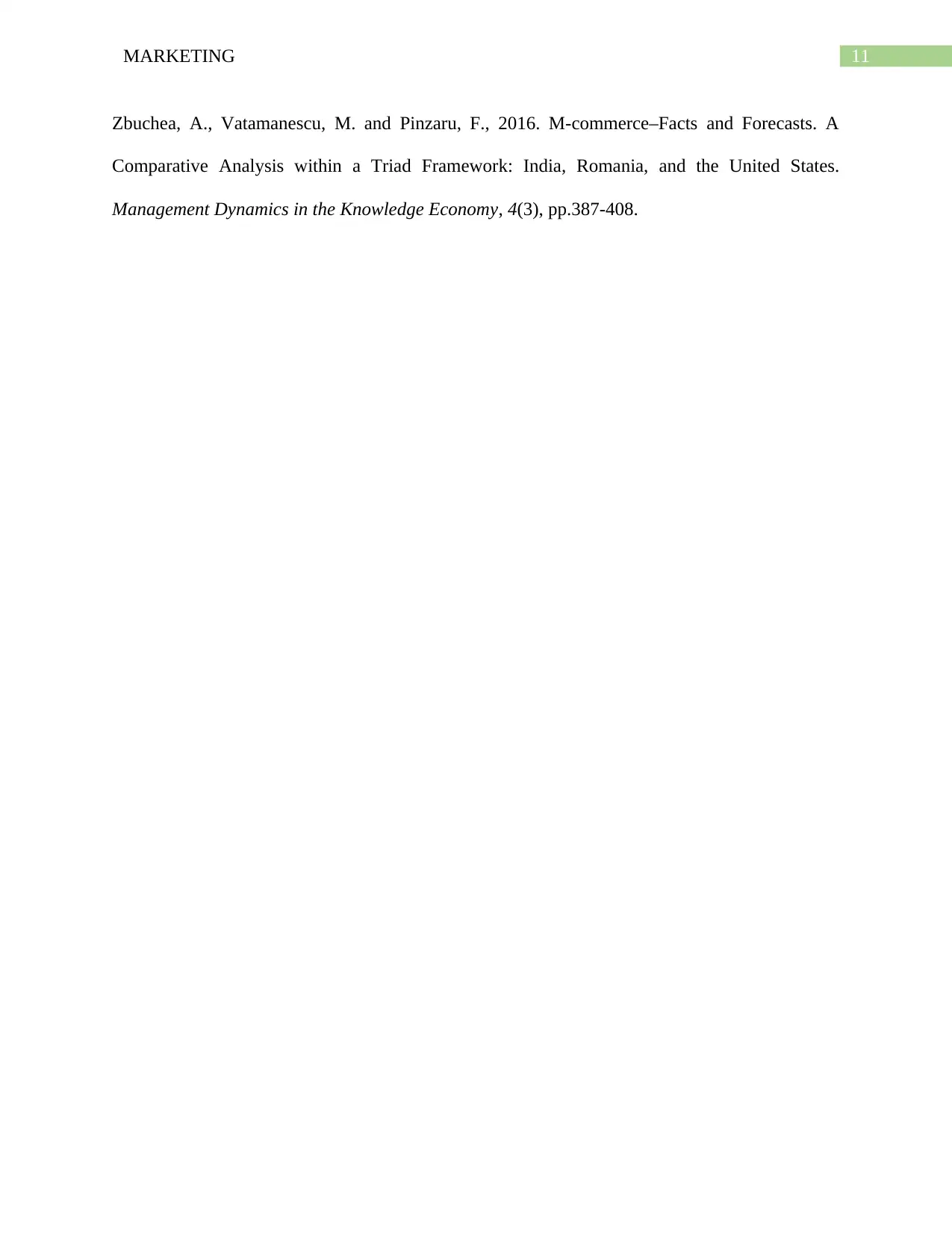
11MARKETING
Zbuchea, A., Vatamanescu, M. and Pinzaru, F., 2016. M-commerce–Facts and Forecasts. A
Comparative Analysis within a Triad Framework: India, Romania, and the United States.
Management Dynamics in the Knowledge Economy, 4(3), pp.387-408.
Zbuchea, A., Vatamanescu, M. and Pinzaru, F., 2016. M-commerce–Facts and Forecasts. A
Comparative Analysis within a Triad Framework: India, Romania, and the United States.
Management Dynamics in the Knowledge Economy, 4(3), pp.387-408.
⊘ This is a preview!⊘
Do you want full access?
Subscribe today to unlock all pages.

Trusted by 1+ million students worldwide
1 out of 12
Related Documents
Your All-in-One AI-Powered Toolkit for Academic Success.
+13062052269
info@desklib.com
Available 24*7 on WhatsApp / Email
![[object Object]](/_next/static/media/star-bottom.7253800d.svg)
Unlock your academic potential
Copyright © 2020–2025 A2Z Services. All Rights Reserved. Developed and managed by ZUCOL.


